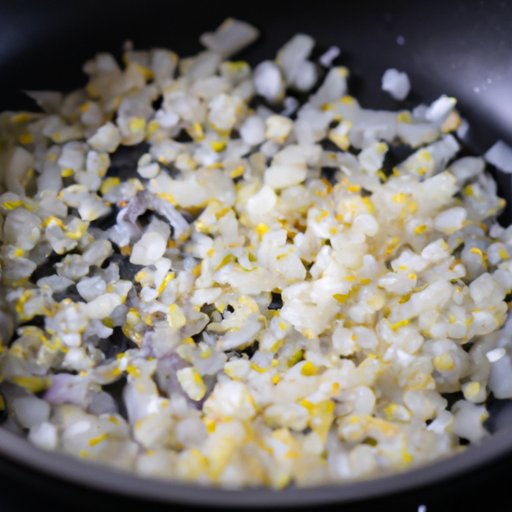Introduction
Sautéed onions are a flavor-packed ingredient that can elevate any dish. From omelets to stir-fries, soups to sandwiches, onions add depth and richness to recipes. Sautéing onions is not only a useful skill in the kitchen, but it’s also easy to master with a little practice. In this article, we’ll walk you through the basics of sautéing onions, share some tips to ensure success, and highlight the many ways sautéed onions can be incorporated into meals.
Step-by-Step Guide
The key to perfect sautéed onions is to start with the right onions. Choose onions that are uniform in size and have tight skins with no soft spots. Avoid using sweet onions for sautéing, as they have a higher water content and can become mushy when cooked.
When it comes to cutting the onions, a sharp knife is important. A dull knife can crush the onion rather than slice through it, which can affect the flavor and texture of the final dish. Dice the onions into small, uniform pieces for even cooking.
Next, prepare the pan for sautéing. Add a small amount of oil or butter to a non-stick or stainless-steel pan and heat it over low to medium heat. Once the oil is hot, add the onions and stir them frequently to prevent burning. Cook the onions until they are soft and translucent, which often takes about 10 to 15 minutes.
One of the most common mistakes when sautéing onions is cooking them over high heat. High heat will cause the onions to caramelize too quickly and become bitter. Additionally, never overcrowd the pan with too many onions, as this can lead to uneven cooking. If you need to sauté a large quantity of onions, cook them in batches.
Spice things up
While sautéed onions are delicious on their own, why not take them to the next level by adding some spices or herbs? There are many flavorful combinations to choose from, including:
- Cumin and coriander
- Garlic and thyme
- Rosemary and black pepper
- Cayenne pepper and paprika
- Ginger and turmeric
When adding spices or herbs to sautéed onions, it’s important to introduce them at the right time. For dried spices, add them to the pan halfway through the cooking process to allow the flavors to meld. For fresh herbs, wait until the onions are nearly done cooking before adding them to avoid overcooking and losing their delicate flavor. And of course, adjust the amount and type of spices and herbs to suit your personal taste preferences.
Health benefits
Onions are a nutritional powerhouse, packed with antioxidants, vitamin C, and other important vitamins and minerals. Sautéing onions can help preserve these nutrients, making them a healthy addition to any meal. If you’re looking to boost the nutritional content of your meal even further, consider pairing sautéed onions with other healthy ingredients like leafy greens, lean protein, or whole grains.
Versatile ingredient
Sautéed onions are incredibly versatile and can be used in a variety of dishes. Here are some recipe ideas to get you started:
Salads
- Grilled Chicken and Onion Salad
- Sautéed Onion and Roasted Tomato Salad
- Spinach and Onion Salad with Dijon Vinaigrette
Pasta dishes
- Shrimp and Sautéed Onion Linguine
- Caramelized Onion and Goat Cheese Pasta
- Tomato and Onion Penne
Soups and stews
- Sautéed Onion and Corn Chowder
- Slow Cooker Beef and Onion Stew
- Chicken and Sautéed Onion Noodle Soup
Common questions
Here are some common questions readers often have about sautéing onions:
Why do onions sometimes burn during sautéing?
Onions can burn if the heat is too high or if they are cooked for too long. To prevent burning, stir the onions frequently and keep the heat on low or medium.
How do I know when the onions are done cooking?
Onions are done cooking when they become translucent and soft. Taste a piece of onion to check for doneness and adjust the cooking time accordingly.
Is it better to sauté onions on high or low heat?
It’s better to sauté onions on low or medium heat to prevent burning and ensure even cooking. High heat can cause the onions to caramelize too quickly and become bitter.
Conclusion
Sautéing onions is an easy and valuable skill to have in the kitchen. By following these simple steps and incorporating spices and herbs, you can create flavorful sautéed onions that can be used in a variety of dishes. Experiment with different flavor combinations and dishes to discover your favorite ways to use sautéed onions.
